#hironobu has a few things but not a lot
Text
This game is holding me at gunpoint and making me write things so uh. I thought I'd share the things
Kakyoin | Asa
I'm not as happy with some of the wording in Kakyoin's bio as I am with Asa's, but I'm still marvelling at the fact I managed to work a fandragon into whatever mess of clan lore I have hfmlfnbfk
#i might make asa into a full-blown jjba oc someday#at the moment i don't even know what his stand's power is. maybe it has acts#cause a little purple squid doesn't seem all that powerful#the lord's work#kakyoin's bio is the most finished thing i have at the moment oops#hironobu has a few things but not a lot#dukaan has a fair bit but none of it is written down#flight rising
0 notes
Text
ScottyMcGeester Plays Every Final Fantasy Game*
*Okay, all the main games except 11 and 14 since they are online only, and also no spinoffs or sequels.
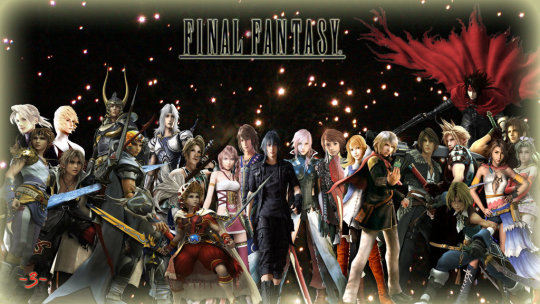
THE INTRODUCTION
Years ago, I had a goal to finish every Final Fantasy game. As of December 30, 2020, I finally reached that goal. I originally started posting these reviews way back in 2017 on VGF(VIdeo Game Forums), and posted one review after another as I completed each game. I had already finished a few before I started reviewing the series, such as Final Fantasy I, II, VI, IX, and X.
Final Fantasy X was my very first Final Fantasy game, way back when it first came out on the PS2. It took me years to finish that game, mostly because I was still a novice at RPGs and I didn’t quite know what I was doing. Still, the world and concepts of Final Fantasy gripped me. As a sci-fi/fantasy writer, they inspired tons of elements in my stories. The series spans a multitude of genre-bending stories – sci-fi, fantasy, some steampunk, modern fantasy, space, traditional fantasy with knights in armor – and a whole lot of crystals.
I wrote these reviews as if you have no idea what Final Fantasy is – whether you are a gamer or non-gamer. This first post is a general introduction to the series as a whole, but even if you are a die-hard fan already, there are some things that I explore that I hope you'll find interesting.
What is Final Fantasy?
Final Fantasy is a roleplay video game series that started back in 1987. The first game was reminiscent of Dungeons and Dragons, where you could choose one of six roles for a team of four: White Mage, Black Mage, Red Mage, Thief, Monk and Warrior.
Square, now known as Square Enix, developed the game. A legendary rumor about the title “Final Fantasy” comes from the story that they were on the verge of bankruptcy. They only had money for one more game, a fantasy game. They dubbed it “Final Fantasy.” This apocryphal story is nowhere near true.
Square had made video games before and they didn’t do well, but the company itself wasn’t on the verge of bankruptcy. What happened was that the developer, Hironobu Sakaguchi, had planned to retire. He didn’t see any foreseeable future in video gaming with Square’s mediocre performance. He wanted to make a fantasy game and dubbed it “Final Fantasy”, since it was to be his personal last work. He also wanted the game to be abbreviated as “FF” – they originally had “Fighting Fantasy” in mind but that name was already trademarked by a board game.
Final Fantasy initially sold 400,000 copies in Japan and became and instant hit. Nintendo of America approached Square to release a localized version for the states. Final Fantasy became far from Sakaguchi’s last game.
What’s Final Fantasy about?
Every main Final Fantasy game has a new story with new characters and even new gameplay. Some games have direct sequels and are recognizable with a subtitle, or an additional number following a dash. For example, there is Final Fantasy VII, and the direct sequel to that Dirge of Cerberus: Final Fantasy VII. There's a direct sequel to Final Fantasy X titled Final Fantasy X-2.
But even though each Final Fantasy game is different, there are still central elements that make them a Final Fantasy game. You can’t just write up a random fantasy story and slap the Final Fantasy name on it. The following elements are what make a Final Fantasy game. Some are obvious while others not so much.
Chocobos:

Chocobos were first introduced in Final Fantasy II, but have been present ever since. They are cute, large birds that the characters often ride across fields or sometimes call into battle. They have practically become the mascot of the series.
Moogles, Cactuars and Tonberries – oh my!
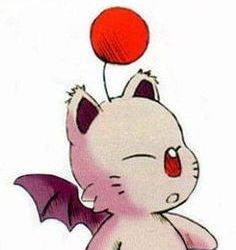
Moogles (pictured above) are telepathic creatures that help the players, or sometimes they can be a playable character. They debuted in Final Fantasy III.

Cactuars (right) and Tonberries (left) are cute, unassuming enemies that are actually highly dangerous, killing you in one shot if you are not careful or fast enough. The former debuted in Final Fantasy VI while the latter debuted in Final Fantasy V.
Summons:

Sometimes they go by different names, like eidolons or espers. Summons are massive, fantastic beasts that you can call upon to aide you in battle to fight the enemy. Summons became a staple ever since Final Fantasy III. In some games, they are merely there to call into battle, while in other games they are central to the story.
Airships:

Airships have been present since the first game. They are massive boat-looking airplanes. In the more recent games, airships look almost like spaceships.
Cid:
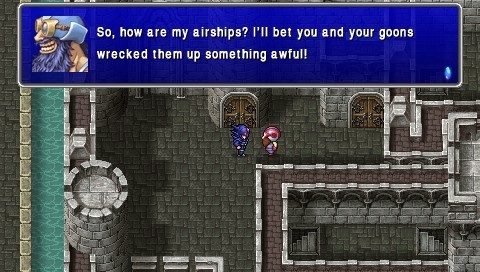
With the exception of the original Final Fantasy (except in later remakes), every game has a character named Cid. Cid is typically the character who owns an airship.
Items and Magic Spells:

Each game shares virtually all the same items and magic spells. Antidotes. Eye drops. Maiden's kiss. Holy water. Phoenix Down is well-known for reviving knocked-out characters in battle. The spells follow a hierarchy of levels. For example, Cure is the basic spell to heal somebody. The second level spell for healing is Cura. Then Curaga. Then finally Curaja. Most other spells follow the same format. The same high-level spells also frequently appear throughout the games, such as Holy and Flare.
Crystals:

With a few exceptions, crystals appear in nearly every game. They often serve as plot devices, whether they be the force that protects the planet or powerful objects coveted by the enemy. They also oftentimes have a consciousness of their own, communicating with the characters and calling them to their destiny.
Mythological References:

Final Fantasy is riddled with mythological references. Many summons and creatures take the names of mythological creatures or deities, such as Shiva, Bahamut, Leviathan, Behemoth, Odin, and Ifrit. Certain villains share the names of mythological figures or they are derived from certain mythological concepts, such as Gilgamesh and Sephiroth. Many of the games have legendary weapons you can find near the end of the journey. These are typically named after legendary Japanese figures, such as Masamune and Yoichi, or other world mythologies, such as Thor’s hammer Mjolnir.
Saving the World:

Final Fantasy isn’t about saving a particular princess, or person for that matter. The ultimate goal is to save the entire world, or even the very fabric of reality. Evil spreads in many ways, such as a sealed darkness trying to break free, empires with ambitious goals, villainous subordinates who pull the strings of politics, or empires destroying the environment. Typically, the main cast consists of characters from all walks of life. They all have to learn to work together and get through their personal struggles to save the world.
Existential Crisis (or Startling Revelation):
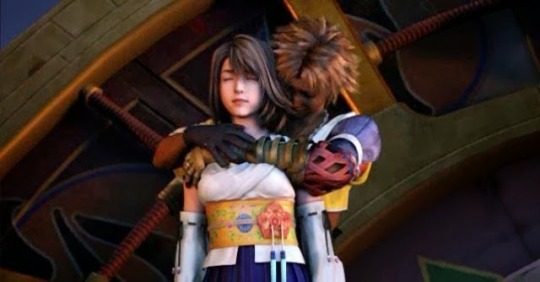
By the time you reach the third act of a Final Fantasy game, some startling revelation forces the characters to question their very existence. A villain is revealed to be a hero’s family member, a main character realizes they're a clone, another realizes that they cannot live without magic, etc. Typically, the main character questions the nature of their soul, if they die like regular beings and become part of some greater life force, or blink out into oblivion. Whatever the revelation may be – it serves as a final crisis that the characters have to overcome.
The Descent into Hell:

Every third act of a Final Fantasy game ends with what I like to call a “descent into hell”. The final dungeon is always some kind of bizarre world. In Final Fantasy II, you literally descend into hell to fight the Emperor. Throughout the series, hell is more metaphorical. The final dungeons can be a massive, sprawling tower or dreadnought, or a strange dimension that appears to have no rhyme or reason. Sometimes I'm reminded of M.C. Escher’s work, “Relativity”, or sometimes it reminds me of some cosmic horror featured in the Cthulhu Mythos. These final dungeons can be inter-dimensional rifts between space and times, pockets in reality, subterranean depths, insane worlds that the villain created, and worlds of darkness.
(Final Fantasy IX's Memoria)
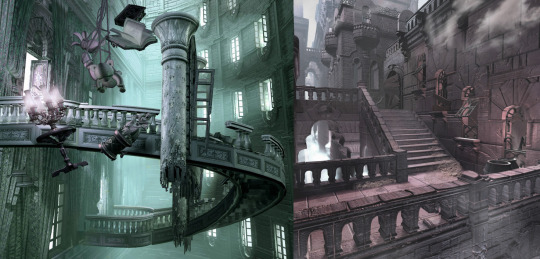
(M.C. Escher's “Relativity”)
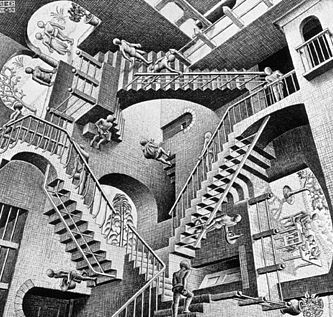
These stylistic approaches for the final dungeon represent the oncoming battle with the forces of chaos.
Fighting God:
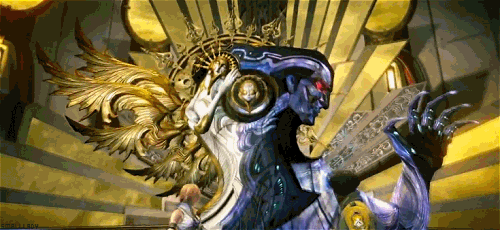
After venturing through the surreal and hellish final dungeon, you face the main villain. The main villain always achieves godlike status or the characters actually have to defeat a god in order to save the world from its oppressive reign. Many stories appear to throw in a last minute ultimate god who was pulling the strings of the plot the entire time. The purpose of dealing with gods and goddesses represents the characters’ desire to control their own fate and alter their destiny. Most of these bosses are strange and grotesque, definitely getting a Cthulhu vibe from them. I looked at them and thought, "Christ, what the hell is THAT supposed to be?"

It always feels like THE final fantasy:
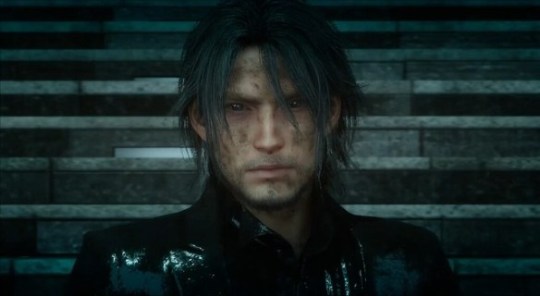
Each game, no matter what happens or how it happens, feels like the be-all-end-all of its story – its fictional universe. Direct sequels were unheard of until Final Fantasy X-2, which while fun, was wildly different in tone from the original game, and critics pointed out that it ruined the finality of Final Fantasy X. This is one reason why I think direct sequels to Final Fantasy games fail – what else could the main characters possibly face that is more dangerous than the one they just encountered? Anything else would feel like child’s play to them.
NOTABLE PEOPLE
Aside from the characters, stories and games themselves, the people behind the series have achieved legendary status.
Nobuo Uematsu:

The original composer of Final Fantasy. Uematsu single-handedly scored the first 9 Final Fantasy games. Uematsu surprisingly never had any formal training in music – a trait that would ostracize any composer, such as Danny Elfman. I find that the those who haven't had any formal training usually break the mold with music. Uematsu started working for Square at around 25 for the first Final Fantasy game, starting out with nothing and never suspecting his job would lead him where he is now. His music is unique for incorporating elements of classic and progressive rock, specifically in the battle themes. Uematsu’s themes for each game have achieved instant recognition in the gaming world, as recognizable as the theme to Star Wars or James Bond.
Tetsuya Nomura:

Tetsuya Nomura is a video game designer and director who started at Square in 1990. He rose to prominence when he was given full control of designing the characters for Final Fantasy VII – arguably the most popular Final Fantasy game to date because of its characters: Cloud Strife, Tifa Lockhart, Vincent Valentine and Sephiroth. Nomura went on to create more legendary characters for Final Fantasy VIII, X and XIII.
Yoshitaka Amano:

Amano is the artist whose work is most known now in Final Fantasy. He has done concept art and design for every game in the series. His style is instantly recognizable. He has also drawn for many anime shows, comics and mangas, such as Vampire Hunter D and Sandman: The Dream Hunters.
And last but certainly not least - THE MUSIC
Final Fantasy has left its mark in the musical soundtrack of video games. Each game more or less shares three of the same memorable tracks.
The Prelude:
youtube
The Victory Fanfare:
youtube
The Final Fantasy Main Theme:
youtube
THE REVIEWS
Each review I post will critique major aspects of each Final Fantasy game, such as its gameplay, graphics, story, and music. Today is currently January 3, 2020 (technically the 4th when I post this because it’s past midnight), and I will be posting one review per day so as to not lose my sanity editing and formatting everything at once here. So look forward to the very first review tomorrow starting with the very first Final Fantasy game.
#final fantasy#final fantasy v#final fantasy vi#final fantasy vii#final fantasy vii remake#final fantasy xv#final fantasy xvi#tifa loc#cloud strife#sephiroth#nobuo uematsu#video games#sony playstation#playstation 5#final fantasy x#onvideogames
118 notes
·
View notes
Text
Dragon Ball Super: Super Hero
youtube
I guess I should provide my hottt takes on the new DBS movie. A few days ago, they did this video for Comic Con announcing the title of the movie and teasing some details about the story.
I gotta say, this is exactly why I’ve never had any interest in Comic Con. They put this on YouTube, I guess because of the pandemic, but any other year they would have gathered an enormous crowd and made them stand in line for hours to watch all of this in person. I live in the Midwest, and when I went to comic book conventions it was for the sole purpose of rummaging through back issue bins. SDCC was always promoted like the biggest and most important convention in the U.S., but all I ever heard about it were trailers for movies and TV shows. Or, like, you had to go to Comic Con because that was the only way to get an exclusive Orange Lantern Hal Jordan action figure or something. They would always hype up all of this useless stuff and I just never heard of anything so important that I was willing to fly out to San Diego and stand in line for three hours for it. So now SDCC peels back the curtain with this video, about something I’m fairly interested in, but it’s really not that big a deal. I found out most of the information on Twitter before I even knew to watch this video.
But I’m just not that hyped about trailers or sneak peaks or sneak peaks at trailers. Which is probably why I waited this long to talk about it.
I’ll just go through the video. The first four minutes are Hironobu Kageyama performing “Cha La HEAD Cha La” live on the stage. That’s a pretty epic way to open this, but I feel like it oversells the importance of this event. You finish watching him and you think you’re about to see the movie itself, instead of hearing from the people who made it.
Next we have Sascha, the host of this panel. He speaks better English than I do, but I’m not sure what the point was in having any of this in English since he has to talk to the guests in Japanese. Pretty much all of the important information in this video is in Japanese, and I think everyone understood that going in. I guess it does give an international feel. If I spoke another language as fluently as Sascha, I’d want to show it off too.
4:56 is where Masako Nozawa comes out, and she’s just a joy to watch. She looks like this sweet grandmotherly figure, all warm smiles and then she busts out “Ossu! Ora Goku!” and immediately sounds like a badass.
Guest #2 is Akio Iyoku, Toriyama’s editor. Not to be confused with the awesome editor who poo-pooed all the androids and Cell’s semiperfect form. That was Yu Kondo. Iyoku comes out dressed like Goku, but he can’t talk like him so he’s immediately second-tier.
Guest #3 is Norohiro Hayashida, Producer from Toei Anaimation. He is also rocking the Goku cosplay, which would be a faux pas in most fandoms, but he can just say that he’s cosplaying as Krillin or Yamcha, which gives him greater nerd credibility because those are more obscure references.
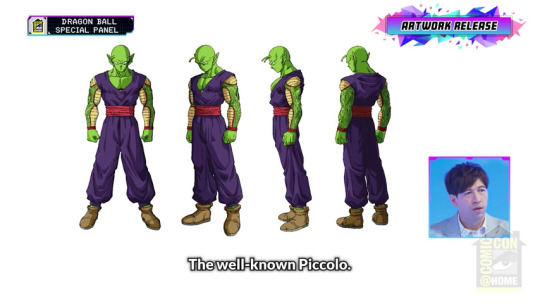
Around 8:30 we really start getting into this, and they show us a model sheet of Piccolo. Is Piccolo being in the new movie a big surprise? He had a dry spell in the mid-90s, but he’s been in every Dragon Ball movie made in this century so far. And it’s not like they changed his look, like when they put Goku and Vegeta in those adorable coats last time. I’m not complaining about any of this. It’s nice to see that a) Piccolo is confirmed for new movie and b) they didn’t tinker with his appearance.
All I’m saying is that they only brought up this model sheet to show off how they’re using his color scheme from the manga as opposed to the anime. Hence the red belt and the yellower arm sections. In the anime, the belt was always blue, and his biceps were hot pink instead of off-yellow. But it’s such a subtle thing that even Sascha didn’t pick up on it. It’s like they were hyping up the fact that it’s such a minor change. I like it, don’t get me wrong, but it’s a weird flex. Also, he looks like he still has his five-fingered anime hands, so I’m not that impressed. Give us four fingers, Toei!
Sascha asks Masako Nozawa what she thinks about Piccolo and she just starts off with “He was Gohan’s teacher,” and talks about how strong and cool he looks. She speaks of him like he’s a family member, because she’s awesome.
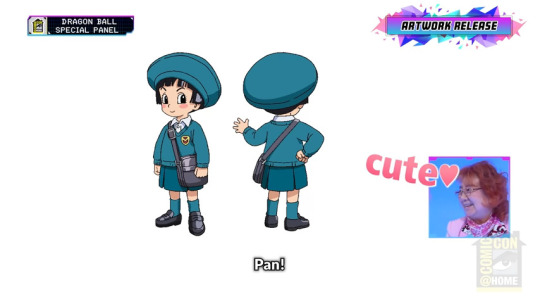
Next up, we have Pan, and now we’re talking. The scuttlebutt is that this was the character Toriyama was referring to when he spoke of an “unexpected character”. And I guess Pan fits the bill, since I don’t think anyone expected her to be this old in the movie. I understand this is her kindergarten uniform, so she’d have to be about five or six years old. I love Masako Nozawa’s reaction here. Throughout this video, you can see that Goku and Gohan aren’t just roles to her.
I’ll put on my fanboy hat here and point out that Pan’s age may imply that this movie takes place after the final episode of Dragon Ball Z. She looks older here than she did when she fought Wild Tiger, at any rate. So far, the entire Dragon Ball Super franchise has been set during the ten-year gap between the Buu crisis and the finale of Z. So everyone has been wondering if DBS would move beyond End of Z, or whether Akira Toriyama even still recognizes the continuity of those final chapters. They were supposed to be ten years of peace, but all the battles in DBS say otherwise. Also, I’m pretty sure Pan and Bulla’s ages in the DBZ finale don’t line up well with their appearances in Super, but I’ve never studied it very closely.
So this might be set post End of Z, or this might be Toriyama retconning End of Z altogether. I’m interested to see which way this goes.
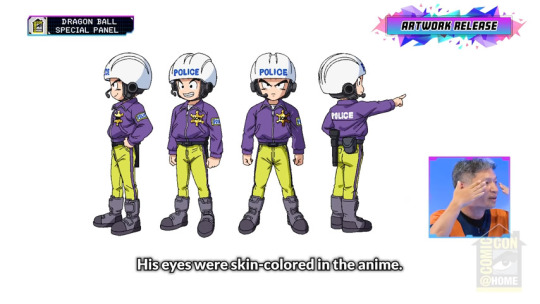
Here’s Krillin, still working for the police, although his uniform looks more like Bronze Age Lex Luthor than anything else. Like Piccolo, the “big” story here is that he’s been tweaked to resemble the coloring in the manga, so his sclera are now white instead of fleshtoned.

Never mind that, here’s Piccolo’s house. This is probably the breakout star of this video, because I think everybody is excited to see Piccolo’s house. Because it’s new lore! No one even knew if he had one or not. It was a running gag in DBZ Abridged that he was homeless. I mean, congratulations to Krillin for getting his eyes colored in right, but that doesn’t tell me anything new about the character. But Piccolo’s house is a big friggin’ deal. What’s inside of there? What’s on the second floor? Check out his mailbox. What kind of mail does he get? It’s exciting.
Nozawa even points out that she and her co-workers would talk about this sort of thing in the recording studio. That’s a big deal to me, that the voice actors think about the same kind of stuff that I do as a fan.
Around 15:30, they start talking about Toriyama’s commitment to the making of this movie, which seems like a weird thing to focus on, because he wrote the screenplay to the last two movies. Did anyone think he was stepping back? I get the impression that there’s still some hard feelings about the failure of Dragon Ball Evolution, in the sense that they want to reassure everyone that we’re still in good hands. I suppose one of these days, Toriyama won’t be as heavily involved in a project like this, so maybe it makes sense for Toei and Shueisha to make it clear that today is not that day.
On the other hand, Toriyama was just as involved with Broly as he was with Resurrection F, and Broly was a much better film. The Dragon Ball Super manga seems to have revived the old argument over who’s to blame when the story is a letdown, and I think that misses the point. Look, the Zamasu arc sucked, and I don’t care who wrote what parts, or whether Toriyama had a bad idea or whether he handed a good idea off that was badly executed. They can hash that out behind the scenes if they want to.
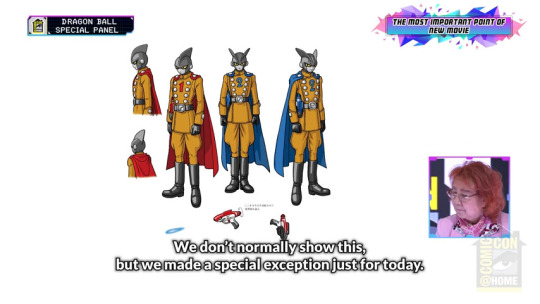
About 19 minutes in, they show us this model sheet, and refuse to explain who these guys are or what they’re doing in the movie. Are they villains? Who knows? I’d like to think they’re important characters to the story, but I have my doubts that Krillin will have a big part to play.
At 20 minutes, they announce the title of the movie, and I’m not very thrilled with “Dragon Ball Super: Super Hero.” They can talk it up as much as they want, and maybe the title is relevant to the plot, but it’s just too many uses of the word “super”. Especially when they’ve got another series called “Super Dragon Ball Heroes” on YouTube.
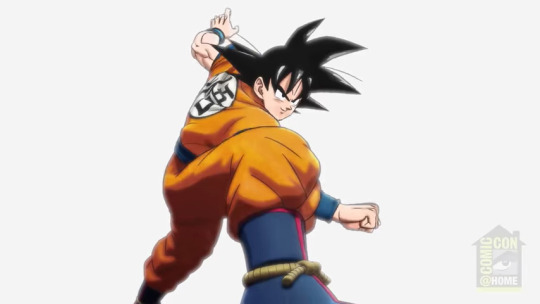
Then we get this teaser trailer, or whatever you want to call it, with a CG Goku hopping around and doing his classic fighting pose. Now, for some reason, lots of people concluded that this means the entire movie will be done in this CG style, which has led to a debate over whether or not that’s a good thing. If they can make the whole movie look this slick, then I’m fine with it. Hell, I’m not picky. They could animate the whole thing in Yukio Ebisawa style, and I’d be thrilled.
But I’m not understanding where people got the idea that it’s definitely going to be a 100% CGI movie. They never spell that out in this video, and they even go out of their way to admit that this shot of Goku isn’t actually from the movie. So is there some other source people are referring to, or did everyone just jump to conclusions?
And that’s pretty much it. I don’t mean to sound negative on this panel, but I don’t feel like they revealed very much, unless this is actually going to turn out to be Piccolo and Pan having an adventure by themselves. I think Toei could make a movie like that and it would be a success, but I have my doubts that they’d go in that direction. If this is going to turn out to be another big slugfest with Vegeta, then I’m down for that too, but don’t show me Piccolo���s house if the movie’s going to be about Vegeta punching a guy.
Bottom line: I’m still looking forward to this, but I don’t feel like I know much more about the movie than I did before. Well, except for the part about Piccolo’s house. I’m looking forward to seeing the inside of it.
5 notes
·
View notes
Text
Was Final Fantasy Really the First JRPG?
https://ift.tt/eA8V8J
1987’s Final Fantasy deserves all the credit it can get for helping popularize the JRPG genre (especially in the West), expanding the scope of NES titles, and kicking off an all-time great franchise, but was it really the first JRPG ever made?
To help answer that question, we first have to define what a JRPG is and what separates that subgenre from tabletop RPGs, CRPGs, ARPGs, strategy RPGs, and every other type of role-playing game out there.
The problem is that defining a JRPG has always been an especially contentious topic. It seems easy to say that a JRPG is an RPG made in Japan, but even that definition doesn’t satisfy everyone. For instance, Dark Souls is an RPG made in Japan, but you rarely hear fans describe it as a JRPG.
You could use common JRPG gameplay/design elements to help define the genre, but even that gets tricky. For instance, I could say that a JRPG has random encounters, turn-based combat, level grinding, and parties of customizable characters, but where does that leave games like Earthbound, Nier, and even later entries into the Dragon Quest and Persona franchises that don’t include all of those elements?
The simpler solution in this instance may be to look at the original Final Fantasy and focus on the elements of the game that later became “tropes” of the JRPG genre and help define the image we form in our head when we think of JRPGs from that era.
What we’re basically looking for, then, is a role-playing game made in Japan that features turn-based combat, random enemy encounters, character leveling, and an overworld you explore between dungeons and quests. If we accept that there was a time when JRPGs were at least partially defined by such qualities (and that deviating from those qualities represented a deviation from subgenre norms) then was Final Fantasy the first JRPG?
Well, the pretty obvious answer to that question is “no.” At the very least, 1986’s Dragon Quest/Dragon Warrior certainly beat Final Fantasy to the JRPG punch. Final Fantasy director Hironobu Sakaguchi has stated many times in the past that his game probably would have never been made if it wasn’t for Dragon Quest‘s surprising success. There’s a complicated conversation we’re about to have regarding the “true” origins of the JRPG genre, but few will deny that Dragon Quest is an earlier example of a JRPG game.
But what if we broaden our definition a bit in an effort to find the first role-playing game released in Japan with natively written Japanese dialog/text that featured at least some of the notable JRPG mechanics that we outlined above? Well, we’d then have to highlight 1984’s The Black Onyx. That game is often credited with helping to popularize turn-based RPG games in Japan, and it was certainly one of the most successful Japanese-language RPGs released exclusively in that country until that point. It’s also hard to look at that game and not see how it clearly influenced Dragon Quest and future JRPGs.
However, because Black Onyx was made by a Western developer (Dutch video game designer Henk Rogers), it’s debatable whether or not it really fits the definition we outlined above. That being the case, let’s throw as much ambiguity out of the window as possible and just try to answer the question “What was the first RPG video game developed by a Japanese studio and released exclusively (or originally) for Japanese gamers?”
Believe it or not, that’s still a surprisingly complicated question. For instance, there were actually quite a few “ARPGs” developed and released in Japan before, or around the same time as, Black Onyx. Titles like Dragon Slayer, Hydlide, and The Tower of Druaga are all some kind of RPG even if they’re not typically what most people think of when they think of JRPGs. While each of those games is worthy of a separate conversation, they’re ultimately little more than a footnote in this particular discussion. After all, we know for a fact that there were RPGs developed/released in Japan before those titles started to help the genre gain mainstream momentum.
Even still, things get a lot trickier when you start to look at Japanese RPGs released before 1984, though. See, in 1981, a Japanese translation of Wizardry became a surprise hit in that country and inspired more Japanese developers to make RPGs and pseudo-RPGs of their own. While you’d think that finding the first JRPG is really just a matter of finding the studio who capitalized on that trend first, the fact of the matter is that a lot of the Japanese-developed RPGs released in the wake of Wizardry were…weird.
For instance, Pony Canyon’s 1982 title Spy Daisakusen (which was strangely based on the Mission Impossible franchise) visually resembles a dungeon crawler of that era, but it’s hard to call it an RPG given that it lacks so many of the key gameplay elements of that genre. There’s also Koei’s Underground Exploration, which was released a few months before Spy Daisakusen and actually features a lot of traditional dungeon crawling/RPG gameplay elements. However, because that game also lacks some of the features that often even vaguely define the RPG genre (such as stats and character-building), it’s hard to cleanly classify it as an RPG without making a pretty compelling outside-the-box argument.
This is the point where I’d also love to tell you more about Koei’s erotic adventure title Seduction of Condominium Wives, but to keep things moving along, let’s just say that it also doesn’t check most of the major RPG boxes. It’s actually closer to a text-based adventure game that so happens to see you battle Yakuza members and ancient spirits while trying to seduce local housewives and sell condoms. Suffice to say, it deserves a remake.
The thing you have to understand about these early “JRPGs” is that Japanese developers and gamers were also still trying to figure out what RPGs meant to them. That’s how we ended up with these wild and experimental blends of adventure games, dungeon crawlers, and the kind of JRPGs we associate with games like Final Fantasy and Dragon Quest. If you want to read a little more about this time period, I highly recommend these excellent articles from PC Gamer and Gamasutra.
More importantly, we actually don’t know a lot about many of the games that were released during that time. So many games of that era have been lost to history or only exist as references in magazines or adverts. That means that there’s a small chance someone actually made a more “traditional” JRPG in the early ’80s and we simply don’t know about it or don’t know enough about it to give it more of the credit it may deserve.
However, there is one more game we have to talk about when talking about the earliest JRPGs ever: Koei’s The Dragon and Princess.
Released in December 1982, The Dragon and Princess features a classic medieval setting, a party of characters, stats, experience points, and, perhaps most importantly, random encounters that force the player to enter a “battle screen” where they participate in tactical RPG combat. While its combat system is a far cry from what we eventually saw in Black Onyx and Dragon Quest (and much the game plays out like a text-based adventure), it’s pretty remarkable how many “core” JRPG elements this game features. It’s arguably become the most accepted answer to the question “What was the first JRPG ever made?” even if people still rightfully debate the nuances of that discussion.
Of course, all of this information just makes Final Fantasy’s obviously inaccurate reputation as the first JRPG that much more confusing. If there were so many Japanese RPGs released before Final Fantasy (including some of the games Final Fantasy was obviously inspired by), then how has Final Fantasy become so closely associated with the earliest days of the genre in the minds of many?
Well, there’s obviously a degree to which the game’s popularity has impacted its historical status. Simply put, Final Fantasy was significantly more popular than so many of the early JRPG experiments that came before. More importantly, Final Fantasy was the first JRPG many Western gamers ever played (though I and others certainly grew up with Dragon Warrior). If Final Fantasy was the first JRPG you played, you’re more likely to remember it as the first JRPG. The fact that the series has remained the most globally popular JRPG franchise has only enhanced its status as a globally recognized JRPG innovator.
That’s not to say that Final Fantasy doesn’t deserve that honor. The way that the game combined the innovations of its predecessors and introduced a few new ideas of its own (including elemental weaknesses, the “party-view” combat screen, and the way it handled classes and party compositions) means that it really does feel like the first “modern” JRPG in a lot of ways. At the very least, it’s the JRPG of that era that would have the biggest impact on the evolution of the genre moving forward.
See, the evolution of the JRPG is similar to the evolution of slasher films. Games like Dragon Slayer, Black Onyx, and The Dragon and Princess are like Psycho, Peeping Tom, and Texas Chainsaw Massacre. They all helped set the stage for the genre, but they were really only adopted into it after the fact as spiritual predecessors. In the case of The Dragon and Princess, you could argue that one of the biggest reasons it wasn’t immediately referred to as a JRPG is that the term really wasn’t a thing at the time of that game’s release.
Dragon Quest, meanwhile, is like Halloween. They’re the earliest and clearest examples of what we now think of when we think of their subgenres. Both were clearly inspired by previous works, and their subgenres would grow to incorporate more ideas soon after their releases, but they showed everybody a clear blueprint to follow and proved that blueprint could be commercially successful. They set the stage for so much of what would come next.
cnx.cmd.push(function() { cnx({ playerId: "106e33c0-3911-473c-b599-b1426db57530", }).render("0270c398a82f44f49c23c16122516796"); });
Sticking to this analogy, I’d say that Final Fantasy is closest to Friday the 13th. Both were obviously inspired by something that came before (and they are arguably derivative of their inspirations in some ways), but the way that they refined and altered elements of their genres made them massive hits, helped kick off a boom period for their respective genres, and helped start franchises that became incredibly successful and innovative in their own right.
Of course, Final Fantasy continues to innovate to this day whereas Friday the 13th arguably peaked when Crispin Glover wildly danced to copyright-friendly music in Friday the 13th: The Final Chapter.
The post Was Final Fantasy Really the First JRPG? appeared first on Den of Geek.
from Den of Geek https://ift.tt/3zY8kpz
1 note
·
View note
Text
The Summer of Adventure: Chrono Cross
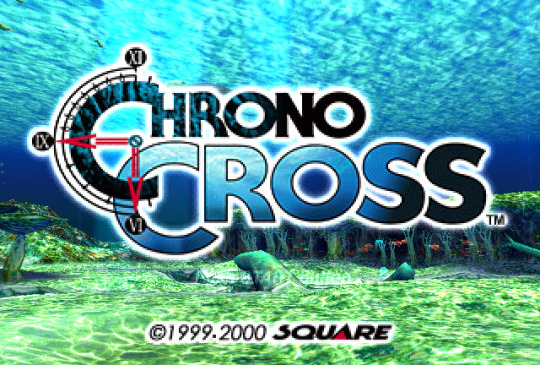
Original Release Date: November 18, 1999 (JPN)
Original Hardware: Sony PlayStation
Chrono Cross is a game that just about every fan of JRPGs has an opinion on. Put in the unenviable position of having to follow up on what many consider to be the best game of all-time in the genre, Chrono Cross chose to take one of the most difficult routes possible. It is undeniably a continuation of the events of the first game, with its main plot serving to tie up one of the loose ends from Chrono Trigger. At the same time, it doesn't seem to be bound by that game at all. At times, it even appears to treat it with contempt. I want to say that Chrono Cross would have been better off as a stand-alone game, but I'm not sure it could have drawn out the same level of emotion from players had it gone that way. Chrono Cross was praised to an almost ridiculous degree when it first launched, but the backlash on it in the years that followed was one of the biggest I've seen in my whole time in the hobby. What's the deal?
Chrono Trigger released with a bang in 1995, riding on the back of a dream team of talents including Final Fantasy creator Hironobu Sakaguchi, Dragon Quest creator Yuji Horii, and famed Dragon Ball artist Akira Toriyama. Its excellent graphics, progressive mechanics, and compelling time travel hook made it an instant winner. Even with more than 20 years down the road, the game is considered to be one of the finest JRPGs and Super NES games. Some would even put it on their short list of the best games of all time. I have friends who make a yearly playthrough of the game a priority, squeezing the game's finite contents for every last drop of enjoyment possible. It's been ported to multiple platforms including the Sony PlayStation, the Nintendo DS, and iOS.

Its sequel would face different circumstances. That dream team had moved on to other things, leaving the less flashy staff members who had shouldered a fair portion of the load of the first game, albeit behind the scenes. The director's chair was occupied by Masato Kato, a well-known game writer who helped pen the stories for Chrono Trigger, Final Fantasy 7, and Xenogears. This was only his third turn as a director, with previous credits on Ninja Gaiden 3: The Ancient Ship of Doom and the Japan-only Satellaview visual novel Radical Dreamers. Perhaps notably, Chrono Cross is also the last game he directed. Naturally, he also provided the story for the game. The game was produced by Hiromichi Tanaka, who would soon take point on Final Fantasy 11. The character designs were provided by Nobuteru Yuki, best known for his work on the anime series Escaflowne.
Considerable talent, to be sure, but the change in directors, designers, artists, and producer made for a game that looked and played almost entirely differently from its predecessor. Besides Kato, the one big returning name was composer Yasunori Mitsuda, the man who had worked himself sick in his composing debut on the first game. Having put a few more games under his belt, Mitsuda was ready and able to deliver a stunning soundtrack that I still think is one of the greatest of all-time. While Chrono Cross had a whole new look and a more confident sound, it was still a great-looking game with some very progressive ideas of its own. One box that would remain unchecked, however, was the time travel motif. There is a little bit of time travel in the story, but you're not the one doing it. Instead, Chrono Cross focuses on crossing between parallel worlds. It's an interesting concept that plays well to Kato's strengths as a writer.
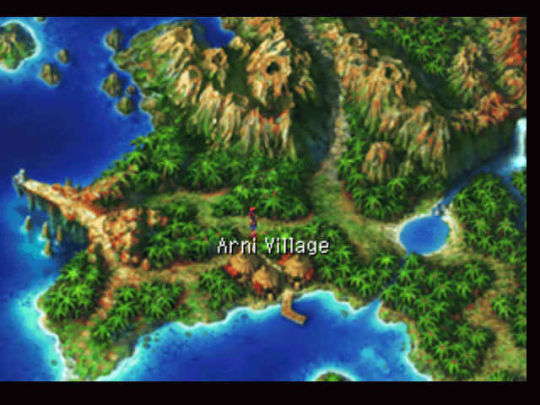
Interestingly, Chrono Cross was the third kick at the can for a sequel to Chrono Trigger. The first, Radical Dreamers, covers part of the same narrative ground. Released only in Japan and exclusively through the Satellaview download service for the Super Famicom, Radical Dreamers introduces some characters that would reappear in slightly altered forms in Chrono Cross, along with a short scenario that would also show up in the latter game. This was only ever meant as a side project, largely existing simply because Kato was annoyed by the loose ends the plot of Chrono Trigger had left. The next potential candidate was the game that would become Xenogears. Initially pitched as an idea for Final Fantasy 7 before another idea won out, it then was planned as a follow-up to Chrono Trigger. After a lot of disagreements, it ended up being its own thing, though it's not hard to spot the connections between it and Chrono Cross.
It was after Xenogears wrapped that Square officially put together a team to create a new Chrono game. The creative talents involved have given some conflicting reasons for the game's dramatic departure from the original game, but the gist seems to be that they didn't feel like rehashing things. They felt doing time travel again would be a cop-out, that a new cast would appeal to potential new players, and that it was important to take full advantage of the new hardware they were working with. As both Tanaka and Kato have strongly asserted, the game's title is not Chrono Trigger 2, so fans probably should not have expected a direct sequel. That kind of feels like a post-hoc excuse to me, but it is what it is.
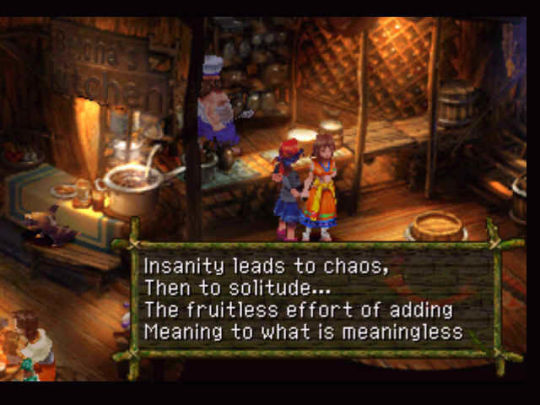
The game released in late 1999 in Japan, but its overseas release would end up coming in August of 2000, not too far ahead of the PlayStation 2 launch. As a highly-anticipated sequel and the culmination of the Summer of Adventure marketing campaign, Chrono Cross came out of the gates like a rocket. The reviews from critics were nearly unanimous in praising the game, with some publications breaking the safety glass on their rarely-used perfect scores to really underline the point. I distinctly recall a major backlash towards American magazine Electronic Gaming Monthly because one of their three reviewers dared to give the game a score of 9.5 out of 10 instead of a perfect score. Given the many shared circumstances between Chrono Cross and Legend of Mana, it's interesting how different the initial reception to each was. But for however much Chrono Cross diverged from Chrono Trigger, it was still quite recognizable in broad strokes. I think that's what saved it from the more immediate negative response its stablemate received.
That said, the negative response did eventually come. It felt like the bigger a fan a person was of Chrono Trigger, the worse they would eventually see Chrono Cross as. Cross had a different, less optimistic tone to it. Rather than focusing on a handful of characters, it chose to spread the love across a huge cast, hoping to fully sell both its world and its high concept. The story broke one of those unwritten rules of fiction. If you give the audience a "happily ever after" ending, revoke it at your own peril. That's just what Chrono Cross did, and it didn't even make a particularly big deal about it. Chrono and Marle died off-screen a long time ago in some random attack from the Porre Army. Lucca's death is an important plot point, but it also happens before the events of the game. Robo at least gets a significant end, but he too does not survive. Ayla, Frog, and Magus don't even appear in the game, with the latter's absence being particularly preposterous as this entire game orbits around his sister, Schala.
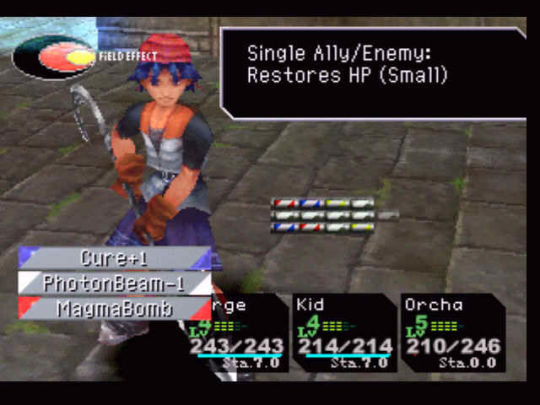
Just in case you think you can delude yourself into thinking the main three aren't really dead, their ghosts actually appear a few times during the course of the game. In short, it was all for naught. Nobody from the main cast of Chrono Trigger got a happy ending, as far as anyone can tell. Heck, you didn't even really save the world. This didn't sit well with many players. Others were put off by the lack of time travel, perhaps expecting there would be some instances later in the game. Even those who could get around these attachments to the plot and characters of the first game were faced with an experience that was almost antithetical to Chrono Trigger.
That game was a fairly light, fast-paced, moderately linear game that wore its messages on its sleeves. Chrono Cross, by comparison, is kind of depressed with existence. The pace is slower, the tone is darker, and the messages are muddier. Although the finished game was heavily pared down from the original plan, it probably could have done with a few more editing passes. For every really interesting, thought-provoking point in the game, there are at least two bits that don't seem to have much purpose at all. Maybe that's intended, though.
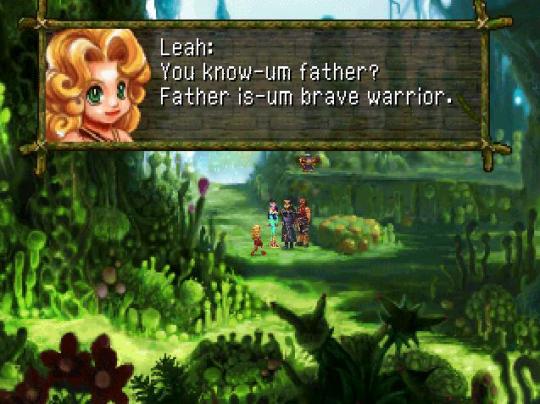
Cross serves as a fascinating counter-point to Trigger in some ways, however. In the latter, your intervention is, as usual for the genre, undoubtedly a good thing. Apart from the early set-up where Marle almost writes herself out of existence, your time-hopping shenanigans never have a negative effect on things, at least as far as you can see. Your presence makes the world a better place, even though you are breaking virtually every fundamental law of nature in doing so. The game ends without addressing this particular karmic debt, and that's fine. It doesn't have to. It's not that type of game.
Chrono Cross has something else to say, though. The premise sees your character Serge traveling to a parallel dimension where he was killed at a young age. After 10 years, this other dimension has a ton of differences compared to your home dimension. The kicker is that many of them make for a better world. Some people are worse off, mind you. But the key is that your existence doesn't make things better for everyone. Indeed, Serge not dying has downright ruined some people thanks to that trusty old Butterfly Effect. One of the more enjoyable aspects of the game is in seeing how people's lives are going in each dimension. At any rate, Serge's death is a good thing for some people. A fact that becomes all the more painful when you discover that Serge was really meant to die. His continued existence comes through unnatural means, and even poses something of a threat to the world order.

This isn't just told to the player, either. There are a number of situations in the game where you have the option to make an active choice versus just passively letting things play out. In some of those cases, your decision to act makes things much worse for everyone, while inaction ends up with the desired result. Like many of Kato's other stories, Chrono Cross eventually ends up being a little bit too on-the-nose with its theme, with a primary antagonist literally named FATE. From a personal point of view, fighting fate is a good thing for Serge. It keeps him alive. But in many ways, it's a purely selfish act of self-preservation. It only accidentally has a good result. Of course, this is all the work of a seriously convoluted plan on the part of Balthasar, the Guru of Time. It seems that pesky old Lavos is still alive and threatens to merge with the missing Schala. Balthasar set all of the events of the game in motion to bring Serge to the point that he could defeat Lavos, preventing it from becoming a Time Devourer and eating all of time and space.
Like the first game, Chrono Cross has multiple endings. The best one involves trying to squeeze out a puzzle-like sequence of special attacks on the final boss, a sequence that you may or may not pick up on from the clues. Should you manage to pull that off, you'll save Schala and be treated to a somewhat bizarre ending where she ponders the meaning of life in the face of evolution and survival of the fittest. It's pretty clearly Kato talking at this point, mind you. Schala concludes that although individual lives may seem to be meaningless if they aren't significant in the evolutionary sense, every being does its part to lead up to those significant examples. Thus, every life is an important part of the chain, so life isn't meaningless after all. Phew, thanks for sorting that one out.

She then signs her letter off in Kid's distinct Australian accent, indicating that her memories have been combined with those of her clone. She promises to find you again someday, sometime. The credits then roll, as a woman who is supposed to be Schala can be seen wandering around various locations in modern-day Japan. It's apparently meant to signal to the player that their very own Kid might be out there somewhere, searching for them. It really only works if you live in Japan, though, since the locations they picked are probably not going to strike a chord with anyone else. To be honest, this is a game full of good ideas and compelling situations, but its main plot ends up collapsing on itself in a way that is highly characteristic of Square games from this era.
This was only my second time playing the game, if you can believe it. I really enjoyed it the first time, but I was definitely high on hype. I wasn't sure how I would end up feeling about it after so many years had passed. I've seen my opinions of Square games I once held sacred turn around in big ways before, and I worried that this might be one of them. At the beginning of the game, as I was enjoying the music, brightly-colored sights, and interesting set-up, I felt that I had perhaps underestimated Chrono Cross. The further in I played, however, the more it started coming back down to Earth. There are too many inconsequential characters, the storyline loses its coherence partway through, and the battle system takes a little too long to sort through in basic skirmishes. This is also a game that virtually demands a guide, and even with one, you're not able to see everything in one playthrough. That's fine, but I don't know that I really want to play this again for a long while. Even the first time, when I was absolutely in love with it, I moved on to other things after getting the best ending.
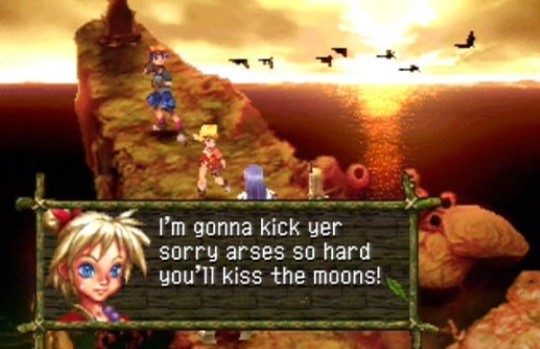
Being a little older and more experienced, I can certainly appreciate some of the ideas the development team tried to apply to the mechanics. That final boss "puzzle" is pretty bad, but in most other respects, I think the element system that governs skills and item use is quite clever. It's a little too restrictive early on, but I like the idea of forcing players to choose carefully what they want in their toolbox. It's a good idea to have a diverse set of skills ready, but if you want to take advantage of field effects, you have to stack certain elements. You might also want to set up a custom set of elements for individual bosses in order to exploit their weaknesses. The only real down point is that this involves a lot of micromanagement that quickly becomes tiresome and isn't totally necessary. I suspect most players will just roll with a general load-out of elements and only change out individual pieces now and then.
I'm always interested in how games try to circumvent grinding. It's been an issue virtually since the inception of the RPG genre, and it's honestly debatable as to whether it's something that needs to be addressed. If players like it, why not give them the option? I guess the problem is that while grinding is often the path of least resistance, it's not fun for everyone. Since it's the most mindless thing to do, people will opt to do it in lieu of trying to reconsider their strategies, even if they don't enjoy it. That leads to people coming away with a poor impression of a battle system that probably would have thrilled them if they had played it without grinding. I think the Japanese focus on intricate combat systems naturally results in designers trying to crack this particular nut.
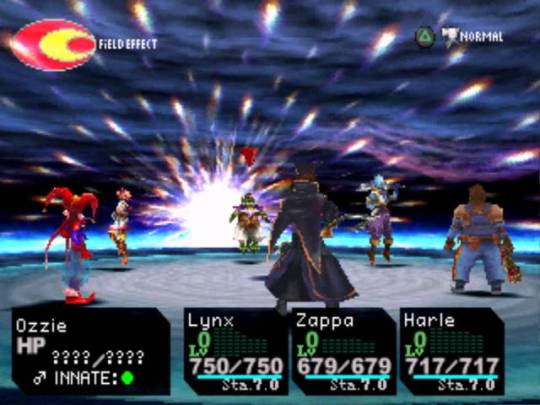
Chrono Cross's approach is to put in hard gates on growth that are connected to your progress in the story. You're given a star ranking that determines how far your party members can grow. Your stats will only see so many gains until you earn a new star by clearing a story boss of some sort. There are other incentives to battling enemies, such as giving you drops that you can use to create new equipment, but you can't simply grind your way past a tough boss. You have to plan your way through it. Luckily, one of the other unique quirks of Chrono Cross assists with that. You can run from any encounter, up to and including the final boss. No, it doesn't make sense from a narrative standpoint, but it makes this one of the fairer RPGs around. Go in, see what elements will serve you best, and if you don't have them, escape.
I think it's that desire to pick away at the accepted standards of the genre that ties the game to its predecessor more than anything. Unfortunately, that's the least likely thing to be appreciated by fans looking for more of the thing they liked before. On top of that, the desire to push the genre in new directions doesn't always work out the way a game's creators might hope for. I don't think anything in Chrono Cross went spectacularly badly, but not many of its innovations proved to be influential. That goes hand-in-hand with its weaker reputation compared to that of Chrono Trigger.
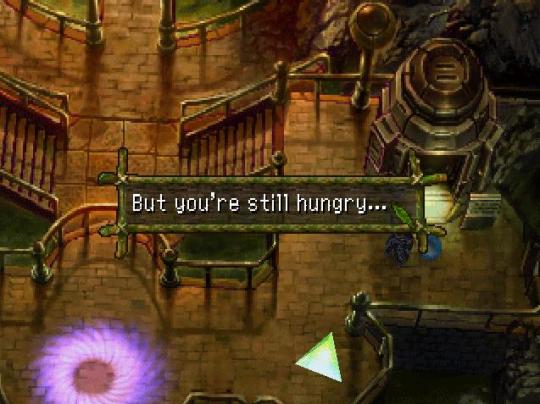
While Chrono Cross isn't entirely forgotten, it does seem like the series as a whole is finished. Chrono Trigger probably has a lot of re-releases in its future, but I'm less confident that Chrono Cross will show up again as anything other than a PSN download. Even Kato's attempt to tie the two games together more strongly in the Nintendo DS port of Chrono Trigger failed to re-ignite interest in Cross. I suppose that speaks to the difficult balancing act that sequels have to pull off. If a game rehashes too much, it will never escape the shadows of those that came before it. On the other hand, if the developer either fails to or chooses not to recognize the qualities that fans appreciated in the original game, history can be swift with the write-off there, too.
It's often the case that when I replay a game, I come away with greater clarity concerning my feelings about it. But even after making my way through Chrono Cross again, I find it hard to nail the game down. I kind of love it. I also kind of hate it. I wish they had cut the fat off it as much as they had with Chrono Trigger. Some of the themes it brings up are brilliant, but others seem like so much belly-button fluff. I think it's a more interesting, more challenging game than Chrono Trigger tried to be. That it failed in many of its ambitions doesn't affect the respect I have for that particular approach. Some small part of me, however, would have been far happier with a safe sequel in this case.

Previous: Threads of Fate
If you enjoyed reading this article and can’t wait to get more, consider subscribing to the Post Game Content Patreon. Just $1/month gets you early access to articles like this one, along with my undying thanks.
1 note
·
View note
Text
The good, the bad and the ugly of British voice acting in games
Tidy!
Warning: accommodates spoilers for the trendy Wolfenstein video games and Closing Fantasy XV
Respectable voice appearing is likely one of the essential constructing blocks of recreation. It’s why so many individuals change the voices to Japanese in JRPGs and the like, as a result of in the event you’re having to learn subtitles for a language you’ll be able to’t perceive, then you’ll be able to’t actually inform whether or not the voice appearing is any good or not. And dangerous voice appearing will be so jarring that it pulls you out of the expertise solely.
Hailing from the UK, the myriad accents and dialects on my small island of origin usually get much less airing in video games than the mighty American accent, however they do make just a few appearances every now and then. Typically, they match to explicit stereotypes that Brits have performed within the media since a time lengthy earlier than video games had been a major type of leisure, a few of that are extremely entertaining and tongue-in-cheek, and a few which can be a little bit grating.
So, let’s dissect a handful of makes use of of the British accent in video games that run the gamut of totally dangerous voice appearing, chewing the surroundings to the purpose of indigestion and speccy librarian sorts.
The Merely Off-putting
My largest WTF second with British accents in video games has been using a kind of bog-standard, barely RP accent in Forbidden Siren, the 2001 horror recreation created by part of Crew Silent. I consider that they intentionally tried to subvert the same old voice-acting expectations of creating all of the English voices sound like Hollywood actors, maybe to provide it some kind of attachment to Victorian horror (see, I sidestepped the dreaded phrase), however there is no such thing as a actual motive for it in a recreation about Japanese mythology. Us Brits are used to all English voice appearing being Americanised, so fairly than being a pleasant addition, it comes throughout as a little bit unusual.
It doesn’t assist that the voice appearing is laughable at components, and the faces of the actors being superimposed on the character fashions lends it a really otherworldly sensation. Maybe it was a sensible choice in spite of everything, provided that it’s a recreation constructed to make you’re feeling on-edge and uncomfortable. Besides that Tamon the professor seems like somebody doing a dodgy Patrick Stewart impression.
youtube
The Ladette
The Final Story lastly obtained a Western launch in 2012, constructed on the hype from the involvement of Closing Fantasy stalwarts Hironobu Sakaguchi and Nobuo Uematsu (get nicely quickly, sir). I used to be listening to my oft-collaborators Cane and Rinse’s episode on the sport, since though I could have finite time to play precise video games, because of my commute, I’ve loads of time to hearken to individuals speak about enjoying video games. Whereas the thought of doing a Medieval-looking JRPG with British accents doesn’t strike me as uncommon, the selection of creating the hard-drinking, rowdy mercenary Syrenne a broad Northern lass is a novel one.
Being from these components of England myself, we get barely any illustration in video games – and for probably the most half, I’m nice with that. Not all video games are suited to comedy portrayals of the stereotypical working class, besides maybe the ye-olde fictionalised middle-England video games that want a rollicking, drunken bard. But it’s fairly good to see wider illustration of the massive vary in accents on the British isles, significantly since builders on different shores are wont to ram all of them collectively to create a complicated mulch.
youtube
The Brainy Ones
I really feel like Buffy the Vampire Slayer has rather a lot to reply for in popularising the “mild bookworm sort” via the character of Rupert Giles, portrayed masterfully by Anthony Head. I actually noticed streaks of Giles once I was enjoying Murderer’s Creed: Brotherhood this week and spent a while with Shaun Hastings. Because the Assassins’ tactician and covert yogurt-stealer, he’s a pleasant bookend to the group – although I did should Google whether or not it was Stephen Service provider doing the voice, as he sounded a little bit bit an excessive amount of like Wheatley from Portal 2.
The distinction between the smart guardian Giles and barely annoying older brother Hastings is that the latter (voiced by comic Danny Wallace) comes throughout as a little bit mean-spirited. I imply, Giles may very well be mildly sarcastic when the Scooby Gang had been placing their lives on the road with out a care on this planet, very like most youngsters do. However Hastings complains a fantastic deal, not lacking a beat in relation to discovering an excuse to verbally snipe at his colleagues. Then once more, we’re a nation of passive-aggressive moaners, so it matches the stereotype, actually.
youtube
The Evil Ones
You didn’t assume I would go away out the evil cackling geniuses, did you? Video games are completely chock filled with baddies who’ve been introduced up with a silver spoon of their mouth, or no less than possess some kind of ambiguous Atlantic lilt to their voice. Assume Albert Wesker of Resident Evil, Claudia Wolf of Silent Hill three and (spoiler alert!) Ardyn of Closing Fantasy XV. Being a destroyer of worlds instructions the very best training cash should purchase, which is why even characters introduced up in a cult in the course of small-town America, like Claudia, one way or the other sound like they withstood hours upon hours of Saturday morning elocution classes.
I’ve to confess, it’s a little boring to see mock obtained pronunciation all the time related to evildoing. From my expertise, individuals who sound like that in actual life spend their time driving their Vary Rovers round unspoiled countryside and capturing grouse, not main a cult to delivery a God, or forging a beefed-up model of Darwin’s survival of the fittest. So that they’re evil, however not that evil.
youtube
The “We’re British Too, You Fool”
Earlier than my many Scottish acquaintances within the gaming journalism world smash down my doorways and provides me a beating, it’s price remembering that the UK isn’t just the little nation of England. Scotland and Wales have been represented nicely in online game voice appearing, although I can not consider many examples in relation to Northern Eire.
I’ve talked earlier than about my favorite little bit of Scottish voice appearing: the park advisor in Theme Park World (solely in PAL copies). I assume I fall into the class of the simply amused, and located his quips had been made all of the extra entertaining by his brogue. One other notable inclusion of the Scottish accent is Fergus in Wolfenstein: The New Order and Wolfenstein II: The New Colossus, although the extent of his presence is decided by whether or not or not you select to provide an automatic lobotomy to him or to a wet-behind-the-ears school grad.
And in relation to the Welsh accent, who may overlook Ni no Kuni: Wrath of the White Witch, with Drippy, the loveable sock puppet who guides Oliver on his quest to save lots of his mom? The thought to provide such a cuddly character and his fellow fairies a fantastic massive booming Valleys accent was impressed, and properly dodged utilizing the same old high-pitched imp voices. Tidy!
youtube
In conclusion, except for the odd Cockney accent used to comedic impact and interval items, Brit voices are sometimes reserved for the baddies and the nerds of video video games. I can’t communicate for all individuals of British heritage, however I’m fairly alright with that. We is likely to be a little bit typecast, however no less than our vocal skills have cornered some a part of the market. And video video games all the time want their deviants and geeks, so we aren’t going anyplace.
Is your accent portrayed nicely in video games? Are you able to consider different cool examples of how the British accent was used and abused within the medium? Let me know within the feedback down beneath!
You might be logged out. Login | Enroll
from SpicyNBAChili.com http://spicymoviechili.spicynbachili.com/the-good-the-bad-and-the-ugly-of-british-voice-acting-in-games/
0 notes
Text
Meet the Staff and Cast of Garo -Vanishing Line-
Garo is a long and storied mixed-media tokusatsu franchise created by Keita Amemiya, who is still credited as original creator on all things Garo. This might sound a bit odd since tokusatsu are strictly live-action. The original series aired in 2005 and since there have been a number of spin-offs, both live-action and animated. On the anime side, production has been handled by MAPPA, which is just the sort of oddball project the studio thrives on. Garo -Vanishing Line- is now the third separate, unrelated anime to be produced, each set in the greater Garo universe of Makai Knights and the ever-present Zaruba. Vanishing Line is the first to be set in a more modern era of the live-action continuities and demands yet another visual overhaul.
The Staff
GARO -Vanishing Line- is the first venture into series directing by Korean animator Seong Ho Park, whose work you've probably seen as the chief animator for the Yuri!! on ICE OP History Maker. A hallmark of his work are low angle perspectives with a lot of camera movement which showed up during several of the fight scenes in episode 1. Park’s resume includes work as a key animator and animation director on several notable series including Fairy Tail, Fullmetal Alchemist: Brotherhood, InuYasha: The Final Act, and even episode 18 of Garo the Animation.
On Series composition is Kiyoko Yoshimura, who also worked on Garo the Animation as a scriptwriter for four episodes and whose writing experience for series including stylized violence and demons includes both Dogs: Bullets & Carnage, Shin Megami Tensei: Devil Children, and Witchblade.
Tomohiro Kishi is chief animation director and character designer, yet another member of the staff who worked previously on Garo The Animation, as an animator. Kishi has filled these dual roles twice before in My Little Monster and 91 Days, the latter of which shouldn't be a surprise considering Sword's more than passing resemblance to Nero. The past experience designing characters in a western setting may come in handy, as the not-New York of Russel City has proven to have a significantly more racially diverse cast than your average anime, including a wide range of physicalities.
Art direction will be led by Yoshimi Mineta, a background artist who is taking this role for the second time after his debut in This Art Club Has a Problem!. Music is being handled by studio MoNaCa, whose sound you will most likely recognize even if you’ve never heard the name. They’re responsible for some of the more memorable pieces from the Monogatari series, Star Driver, and have worked on each of the Garo animations.
The Cast
Sword is played by Tomokazu Seki who has more than likely showed up in at least one of your favorite anime, with roles including Kogami in Psycho-Pass, Van in Escaflowne, Touji in Neon Genesis Evangelion, Gilgamesh in the Fate series, Touya in Card Captor Sakura, Sousuke in Fullmetal Panic, and Chichiri in Fushigi Yugi. Funnily enough, the voice actor for Sword also played Katana in Coyote Ragtime Show and has played a minor role in both previous Garo anime.
Rie Kugimiya, the voice of the heroine Sophie, should also sound familiar. Her credits include Alphonse in Fullmetal Alchemist: Brotherhood, Juuzou in Tokyo Ghoul, Kagura in Gintama, both White and Black in Blood Blockade Battlefront, Aguri in Precure, and both Karin and Nemu in Bleach.
Strangely enough, the voices of Sword and Sophie have crossed paths before as talking cats playing Lucky and Happy in Fairy Tail.
The supporting cast also has some notable names. The voice of Luke is none other than Nobunaga Shimazaki, who is also playing Yuno in Black Clover this season, but also played the protagonists of Ace of Diamond’s Satoru, Free!’s Haruka, and Grimgar’s Manato. Gina’s voice actress Koshimizu Ami who is notable for her roles as Makoto in Sailor Moon Crystal, Kallen in Code Gaess, Anemone in Eureka Seven, and Ryuuko in Kill la Kill.
The only returning member of the voice cast is Hironobu Kageyama, who plays Zaruba, one of the few constant characters that persist through the series. Zaruba is, in fact, one of his only voice acting roles as his primary career is a musical artist and the lead singer for the majority of the Dragon Ball Z opening themes, including everyone’s favorite: CHA-LA HEAD CHA-LA.
Each iteration of the Garo anime have been a dramatic departure from the last and Vanishing Line’s western setting and ‘90s action feel are no exception. MAPPA seems up to the task, putting together a team who both have prior experience with Garo and have touched series with a more modern, demon-hunting aesthetic. Since the live-action side of the franchise is set in modern day, there is plenty of visual material for the team to pull from. The thing to watch may just be how the entire production comes together at the end, as the standout choice for the team would seem to be the untested director Seong Ho Park. Now at the midpoint of the season, there is definitely no shortage of highly-stylized action to be found.
---
Peter Fobian is Features and Reviews Editor for Crunchyroll, author of Monthly Mangaka Spotlight, writer for Anime Academy, and contributor at Anime Feminist. You can follow him on Twitter @PeterFobian.
0 notes
Text
1UP Reblog: Four Reasons to be Excited for Pandora’s Tower
Pandora’s Tower was released in the US a couple of weeks ago. Just as I suspected, It didn’t make a lot of noise.
But If you own a Wii (or a WiiU) that’s just sitting there collecting dust, stop complaining and get it. It’s really good. If I had to review it, I’d give it a 7.5/10. A real 7.5/10, not a fake one that you give games nowadays to say they’re bad without saying it.
Anyway, here’s a thingy I wrote for 1Up a year ago. I thought editing it a bit and reblogging it would have been a nice idea. I hope it gets you interested in the game.
///////////////////////////////////////////
The Last Story is about to thunder across the U.S. skies; the beautiful Xenoblade Chronicles has struck. While the incredible community effort of Operation Rainfall probably isn’t entirely to credit for the U.S. release of these games, it certainly didn’t hurt. Operation Rainfall comprised three games, and unlike the first two the third – as yet unannounced for American audiences – has met with a tepid reception in Europe: Pandora’s Tower. The Last Story and Xenoblade came from established creators Hironobu Sakaguchi and Tetsuya Takahashi, men who built their reputations with titles like Final Fantasy and Xenosaga. Next to such legacies, Pandora’s Tower seems comparatively diminished and unattractive – and its clearly limited budget certainly doesn’t help.
But beneath Pandora’s Tower modest looks beats the heart of a great game.
The Scar
The game’s plot revolves around two lovers, Aeron and Elena. The former is a deserter, running from the horrors of war. The latter is a kind girl who has been struck by a horrible curse that transforms her into a beast that feeds on human flesh and is thus wanted by the Elyrian Kingdom army.
For an action RPG, Pandora’s Tower has quite an immense and detailed world… one that you won’t visit but throgh well written dialogues and forgotten documents retrieved during your adventures that will certainly tickle your imagination, making the tale’s setting unbelievably genuine.
The game takes place entirely in a very small environment, a complex called “The 13 Towers”: A forgotten fortress held afloat by 12 chains pierced into the surrounding cliffs. These chains prevent a huge chasm that scars the land of Elyria from widening and opening a path to the netherworld.
The tale starts when the two fugitives find refuge in a observatory used in ancient times to monitor the arcane experiments taking place in The 13 Towers. Little do they know that their escape has kindled the flame of war across the entire continent. And even if these events are nothing but a distant echo, the story will change significantly according to the couple’s actions, leading to multiple unpredictable endings that will not only affect the fate of the main characters, but also the balance of the entire world.
The Hunger Game
Pandora’s Tower is a very delicate game, but it can also be brutal. It knows how to reward the player, but at the same time knows how to punish mercilessly, and Aeron and Elena are the ones who pay for your mistakes.
The cursed mark on Elena’s back slowly sends her through a horrible transformation that seems to have come straight out of David Cronenberg’s nightmares. When she mutates, even the plants alongside her suffer, becoming grey and sickly. To keep his beloved sane and stop her metamorphosis , Aeron has to explore the tower and obtain monster flesh to feed her. The detail that went into creating realistic pieces of dripping monstrous meat and the cutscenes that show Elena consuming them are hands down the most disturbing thing that you’ll ever see in a video game. Some are so horrible I had to skip lunch while playing – and meatballs, my favorite food, were served that day.
What’s worse is that, as the game progresses, the heroine begins to enjoy her meals, leading to sickening moments that almost outdo the famous scene from eXistenZ in which Pikul enjoys his Chinese “special.” According to Toru Haga, the game’s director, this idea came while eating lunch on a train to work. Eating is, after all, such a normal action, part of everyone’s daily routine, and transforming it into a disturbing, painful experience is a smart way to both impress the players and help them empathize with Elena.
The game is a love triangle with death.
Aeron can interact with his belle in a variety of ways reminiscent of dating simulations, but Elena is not the typical damsel in distress, and does her best to fight her disease, while hiding the anguish of being in such a state to avoid burdening Aeron further. She even has a central role in the gameplay. Give her presents, and instead of just greedily accepting them, she will convert them into useful items: She can cook, sew bigger inventory bags, even translate documents from unknown languages.
Elena is a vivid character, beautifully portrayed by the numerous cutscenes…and these change depending on how your bond with her develops. It’s hard not to care about her, and developer Ganbarion succeeded in transferring the drama of the couple onto the player’s shoulders. You will want to make sure she’s okay.
But make her unhappy and… Well, you don’t wanna end up devoured in the name of love, right?
The Silent Protagonist
Aeron is a man of few words. His actions speak for his heart and cut through his silence. His feelings are always clear thanks to his body language, and particularly his deep, expressive eyes: Note his kind love and determination with each intense stare at the suffering elena, or the modesty that surfaces when he looks away away shyly when she is happy and grateful.
And yet, Aeron is as lethal as he is sweet. He can cut a path through horders of enemies using a variety of weapons with exquisite expertise - from swords to scythes, each with a distinct move set and stats that can be improved via forging.
The gameplay is simple; you can combine basic attacks together or unleash a number of special charge moves that differ from arm to arm. But what makes it fresh and original is the Vestran chain, a sub-weapon capable of interacting with enemies in a crazy amount of ways. You can bind monsters’ legs to make them fall, then drag them or strangle them; you can tie them to pillars to stop them from advancing, or even steal their weapons and lash back.
The game gives its best in the battles against the tower masters, often peaceful Shadow of the Colossus-like creatures – have fun with the moral implications – with interesting patterns to learn to expose their weak points via chain interaction.
Exploration is equally inspired, and the game doesn’t handhold the player, but lets him free to explore the environments and solve Zelda-flavored puzzles, often forcing him to rely on mere observation to understand the level layout and how to proceed. It makes Pandora’s Tower harder, but also gives the player the thrill of understanding every riddle on his own. If Castlevania’s developers would try this game and see how Gambarion made wise use of the Vestrian chain’s whip-like gimmick, they’d finally get an idea how to create a 3D title worthy of the series’ name.
Pandora’s Tower is a game with a lot of heart, and it makes up for its limitations with inspired art direction, a superb story, and pristine level design. Let’s hope that Nintendo presents the game at E3 so everyone can give it the chance it deserves.
///////////////////////////////////////////
Of course, last E3 is long gone. But the game is out, why haven’t you bought it yet!?
0 notes